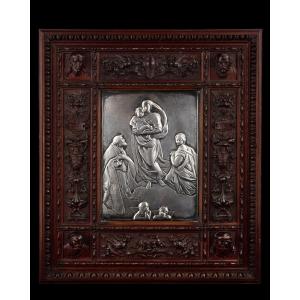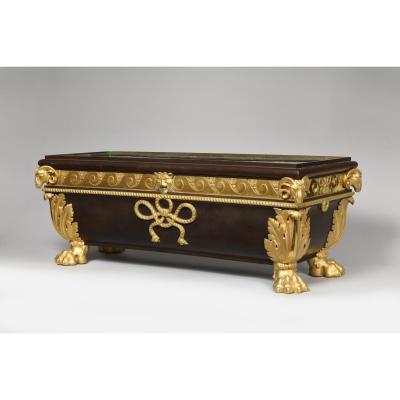Gilt and patinated chased bronze.
France.
Directoire.
↕ 65 cm.
A pair of three-light candelabra in finely chased, gilt and patinated bronze.
On their patinated bronze cylindrical bases, surrounded by palmettes-zone, masks and draperies, stands a patinated bronze couple, dressed in Antique style. Their hair and the drape of their toga showcase an impressive chasing. They carry one vase each, and from the vases emerge the arms of light, decorated with white poppy flowers and leaves.
The shape of those gilt bronze flowers seems to follow exaclty the description given in the French Encyclopédie of Diderot and d’Alembert :
It bears many tall, large, whitish-green leaves, sharply cut on the edges. Its stem is round and sound. It can rise as high as five or six feet. It is surrounded by leaves that are shorter and larger than those of the other poppies. Near the top, it divides into three or four branches, each of which bears a round head at the tip, drooping at first, then straightened out, as the flower opens.
The first three gilt bronze white poppy flowers are at different stages of their growth : the first is a round head calyx slightly drooping, the second a flower which corolla is about to open, the third a poppy flower half open. Higher up, the three nozzles are shaped like white poppy on the verge of fully blooming.
There were two other similar pairs registered in the French Mobilier National in 1911. One was at the Palais de l’Élysée, the other at the Hôtel de la Marine, then Ministry of the Navy. Ours, however, are remarkable by their size : 65 cm high, compared to the 50.5 cm of those at the Élysée.
As for pairs of the same size of this iconic model, two went on sale in the 21st century : one was sold for £24,000 at Sotheby's on November 28, 2006 ; the other, sold at Koller on September 21, 2006 for 16,000 CHF.
Sources
Louis Jean-Marie Daubenton, in Encyclopédie, ou Dictionnaire raisonné des sciences, des arts et des métiers, s. v. « Pavot », vol. XII, n° 689-690, Paris, 1765.
Ernest Dumonthier, Les Bronzes du mobilier national, t. II, Paris, 1911.








































 Le Magazine de PROANTIC
Le Magazine de PROANTIC TRÉSORS Magazine
TRÉSORS Magazine Rivista Artiquariato
Rivista Artiquariato